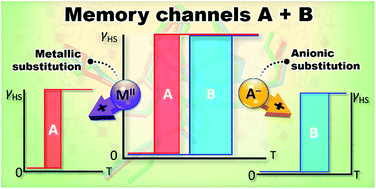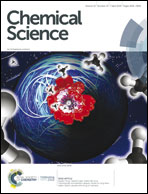Discrimination between two memory channels by molecular alloying in a doubly bistable spin crossover material†
Abstract
A multistable spin crossover (SCO) molecular alloy system [Fe1−xMx(nBu-im)3(tren)](P1−yAsyF6)2 (M = ZnII, NiII; (nBu-im)3(tren) = tris(n-butyl-imidazol(2-ethylamino))amine) has been synthesized and characterized. By controlling the composition of this isomorphous series, two cooperative thermally induced SCO events featuring distinct critical temperatures (Tc) and hysteresis widths (ΔTc, memory) can be selected at will. The pristine derivative 100As (x = 0, y = 1) displays a strong cooperative two-step SCO and two reversible structural phase transitions (PTs). The low temperature PTLT and the SCO occur synchronously involving conformational changes of the ligand's n-butyl arms and two different arrangements of the AsF6− anions [T1c = 174 K (ΔT1c = 17 K), T2c = 191 K (ΔT2c = 23 K) (scan rate 2 K min−1)]. The high-temperature PTHT takes place in the high-spin state domain and essentially involves rearrangement of the AsF6− anions [TPTc = 275 K (ΔTPTc = 16 K)]. This behavior strongly contrasts with that of the homologous 100P [x = 0, y = 0] derivative where two separate cooperative one-step SCO can be selected by controlling the kinetics of the coupled PTLT at ambient pressure: (i) one at low temperatures, Tc = 122 K (ΔTc = 9 K), for temperature scan rates (>1 K min−1) (memory channel A) where the structural modifications associated with PTLS are inhibited; (ii) the other centered at Tc = 155 K (ΔTc = 41 K) for slower temperature scan rates ≤0.1 K min−1 (memory channel B). These two SCO regimes of the 100P derivative transform reversibly into the two-step SCO of 100As upon application of hydrostatic pressure (ca. 0.1 GPa) denoting the subtle effect of internal chemical pressure on the SCO behavior. Precise control of AsF6− ↔ PF6− substitution, and hence of the PTLT kinetics, selectively selects the memory channel B of 100P when x = 0 and y ≈ 0.7. Meanwhile, substitution of FeII with ZnII or NiII [x ≈ 0.2, y = 0] favors the low temperature memory channel A at any scan rate. This intriguing interplay between PT, SCO and isomorphous substitution was monitored by single crystal and powder X-ray diffractometries, and magnetic and calorimetric measurements.



 Please wait while we load your content...
Please wait while we load your content...